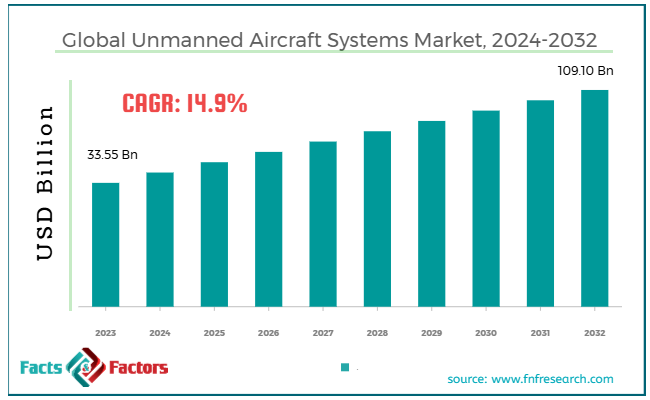Search Market Research Report
Unmanned Aircraft Systems Market Size, Share Global Analysis Report, 2024 – 2032

Unmanned Aircraft Systems Market Size, Share, Growth Analysis Report By Type (Fixed Wing, Rotary Wing), By Size (Very Small UAS, Small UAS, Mini UAS, Large UAS), By Range (Close Range, Short Range, High Range), By Energy Source (Traditional Airplane Fuel, Battery Cell, Fuel Cell), By End User (Civil, Military, Commercial), And By Region - Global Industry Insights, Overview, Comprehensive Analysis, Trends, Statistical Research, Market Intelligence, Historical Data and Forecast 2024 – 2032
Industry Insights
[214+ Pages Report] According to Facts & Factors, the global unmanned aircraft systems market size was worth around USD 33.55 billion in 2023 and is predicted to grow to around USD 109.10 billion by 2032, with a compound annual growth rate (CAGR) of roughly 14.9% between 2024 and 2032.

 Market Overview
Market Overview
Unmanned aircraft systems (UAS) are aircraft that function without a human pilot. They comprise drones, communication links, and a ground control station. These aircraft can be controlled remotely or independently and are used in various applications. The global unmanned aircraft systems market is projected to witness remarkable growth over the forecast period owing to the rising demand for UAS in numerous industries, improvements in technology, and expanding commercial uses.
UAS comprises the systems needed for their control, like software, ground control stations, and communication links, as well as unmanned aerial systems. Industries like logistics, agriculture, infrastructure inspection, and construction are widely adopting unmanned aircraft systems for tasks like mapping, precision agriculture, surveying, surveillance, and delivery services.
Furthermore, military applications like surveillance, intelligence gathering, and reconnaissance are propelling the market growth. Also, rising defense budgets in numerous economies and burgeoning demand for tactical drones are majorly contributing to the industry expansion.
However, the global market is hindered by regulatory challenges and privacy & security issues. Despite the growing number of supportive regulations, a few barriers to airspace management, privacy issues, and safety concerns still exist. Most governments are careful when permitting drones to function in sensitive and crowded places, which could restrict their applications.
Moreover, drones embedded with sensors and cameras raise privacy distress, mainly in urban places. Cyberattacks on these systems and data breaches are a few other risks. Also, the possible misuse of drones for criminal activities like spying, smuggling, and terrorism has resulted in elevated security issues.
Yet, the unmanned aircraft systems industry is favorable for substantial growth with factors like speedy development of the urban air mobility (UAM) sector and increasing use in precision farming. The UAM sector is rapidly developing with applications like drone-based urban logistics and passenger transport. Companies like Google, Amazon, and UPS are actively exploring drone delivery systems to provide speedy and efficient goods transportation.
Moreover, unmanned aircraft systems in agriculture offer prospects to improve irrigation management, crop monitoring, pesticide application, and soil analysis. This segment is projected to progress majorly as UAS can reduce costs and boost production.
 Key Insights:
Key Insights:
- As per the analysis shared by our research analyst, the global unmanned aircraft systems market is estimated to grow annually at a CAGR of around 14.9% over the forecast period (2024-2032)
- In terms of revenue, the global unmanned aircraft systems market size was valued at around USD 33.55 billion in 2023 and is projected to reach USD 109.10 billion by 2032.
- The unmanned aircraft systems market is projected to grow significantly owing to growing demand for monitoring and surveillance, increasing defense and military applications, accessibility and cost efficiency, and supportive government regulations.
- Based on type, the fixed wing segment is expected to lead the market, while the rotary wing segment is expected to register considerable growth.
- Based on size, the very small UAS segment is the dominating segment among others, while the small UAS segment is projected to witness sizeable revenue over the forecast period.
- Based on range, the close range segment is the leading segment, while the short range segment is projected to gain a notable share over the forecast period.
- Based on the energy source, the battery cell segment is the dominating segment, whereas the traditional airplane fuel segment is projected to witness a substantial share in the future.
- Based on end user, the commercial segment is expected to lead the market as compared to the military segment.
- Based on region, North America is projected to dominate the global market during the estimated period, followed by Asia Pacific.
 Growth Drivers
Growth Drivers
- Rising demand for autonomous UAS propel the global unmanned aircraft systems market growth
Autonomous unmanned aircraft systems that are capable of performing jobs with the least human contribution are actively being adopted in industries like infrastructure inspection, agriculture, and logistics. Machine learning and artificial intelligence are improving the capability of unmanned aircraft systems to function in extreme environments without direct oversight of humans. The global autonomous systems market in the said industry is anticipated to grow at 8.2% CAGR with a valuation of USD 43.54 billion by 2030. Autonomous systems are especially used for tasks like delivery services, crop monitoring, and wildlife monitoring.
Leading companies, such as Amazon, are actively spending on autonomous UAS for last-mile delivery facilities. The company has been leading pilot programs for drone-enabled deliveries, seeking highly efficient and faster distribution in rural and urban areas. This move is projected to transform the global logistics industry.
- The use of UAS in emergency response and public safety spurs market growth
Drones have proven themselves to be of utmost use in emergency response like rescue and search, firefighting, and disaster relief. They offer access to hard-to-reach locations, real-time situational awareness, and help manage operations in emergency cases. The use of drones in such emergency cases is projected to progress by 10% yearly by 2030. Along with this, the demand for disaster management and public safety is also propelling. Drones can efficiently offer vital information for emergencies, thus saving lives and reducing response times.
In California, drones were used for search-and-rescue assignments and wildlife monitoring. The use of drones offered aerial views in real-time, helping the fire departments to make better decisions. In Europe, drones are widely used in earthquake and flooding response operations to direct resources and access damage more effectively.
 Restraints
Restraints
- Restricted payload capacity and battery life hamper the progress of the unmanned aircraft systems market
One of the major factors hindering the growth of the unmanned aircraft systems industry is the restricted battery life. Low battery life significantly limits the flight time and operational range of drones.
In addition, the payload capacity of drones is a major obstacle, mainly for military and commercial applications that need extended operations or heavy equipment. The average battery life for the regular drones is usually 20-30 minutes, while the advanced drones hold 60-120 minutes of flight time.
Amazon Prime Air declared delays in the drone delivery event in November 2023 due to issues regarding the regulatory approval process and battery life restrictions. The company is currently occupied with novel drone models with comparatively long flight times and enhanced payload management to resolve this limitation.
 Opportunities
Opportunities
- Growing use of drones in precision farming and agriculture propel the unmanned aircraft systems market growth
Drones are broadly used in modern agriculture for jobs like pest control, crop monitoring, field mapping, and fertilization. This offers farmers with real-time insights to reduce costs, enhance production, and increase sustainability. The agricultural drone industry is projected to progress from USD 4.9 billion to USD 14.8 billion from 2022 to 2030 at a 15.2% CAGR. Drones offer growers better actionable information, thus enhancing resource management and crop monitoring.
In 2023, DJI launched a novel drone model specially designed for farming. This model was equipped with improved sensors for spraying and crop analysis in real-time. This focus on drone’s rising significance in the farming sector as farmers seek to fuel productivity with precision systems.
 Challenges
Challenges
- Lack of standardization and technological limitations limit the growth of the unmanned aircraft systems market
Despite improvements, technological restrictions in UAS capabilities hamper the growth of the unmanned aircraft systems industry. Problems like real-time data processing, sense-and-avoid technology, swarming capabilities, and battery efficiency are still progressing.
Moreover, the lack of global standardization for drone software, hardware, and safety regulations further complicates interoperability in diverse industries and regions.
The EASA (European Union Aviation Safety Agency), in 2023, reported issues regarding the lack of universal standards for unmanned aircraft systems, mainly for autonomous flight drones. This restricted consistency creates obstacles to cross-border drone functioning, thus restricting international UAS adoption. EASA is currently working on improving regulatory standards to overcome these technological breaks.
 Report Scope
Report Scope
Report Attribute |
Details |
Market Size in 2023 |
USD 33.55 Billion |
Projected Market Size in 2032 |
USD 109.10 Billion |
CAGR Growth Rate |
14.9% CAGR |
Base Year |
2023 |
Forecast Years |
2024-2032 |
Key Market Players |
DJI, General Atomics, Northrop Grumman, Lockheed Martin, AeroVironment, Textron Systems, Elbit Systems, Boeing, Insitu, Parrot Drones, Bae Systems, Raytheon Technologies, Thales Group, Wing (Alphabet Inc.), Quantum Systems, and Others. |
Key Segment |
By Type, By Size, By Range, By Energy Source, By End User, and By Region |
Major Regions Covered |
North America, Europe, Asia Pacific, Latin America, and the Middle East &, Africa |
Purchase Options |
Request customized purchase options to meet your research needs. Explore purchase options |
 Segmentation Analysis
Segmentation Analysis
The global unmanned aircraft systems market is segmented based on type, size, range, energy source, end user, and region.
Based on type, the global unmanned aircraft systems industry is divided into fixed wing and rotary wing. In 2023, the fixed wing segment held the maximum share owing to longer endurance and extraordinary payload capacity. Fixed-wing drones can capably cover greater distances and stay in the air for extended periods than rotary-wing or multirotor drones. They have a similar design to the traditional aero planes, permitting efficient flights for long ranges. This makes them suitable for multiple applications like mapping, surveillance, agriculture, and military reconnaissance. Moreover, these drones are usually capable of holding much heavier loads like sensors, cameras, and most other equipment owing to their design and structure. This increases their suitability for high-end uses like large-scale surveying, environment monitoring, and delivery.
Based on size, the global market is segmented as very small UAS, small UAS, mini UAS, and large UAS. The very small UAS segment is projected to hold a notable share over the estimated period due to its extensive use for recreational, consumer, and low-scale commercial purposes. They are widely used for tasks like video recording, aerial photography, and hobbyist flying. Moreover, besides their small size, their affordability makes them more prominent among small businesses and individuals. The segment is majorly driven by its increasing commercial use, low-cost, and emerging applications. The dispersion of drones among consumers has majorly fueled segmental growth. Their ease of use has further increased their appeal to enthusiasts and beginners. Also, very small UAS are actively used for delivery services, mainly in urban areas for small parcels.
Based on end user, the global unmanned aircraft systems market is segmented as civil, military, and commercial. In 2023, the commercial sector registered a substantial share owing to cost-efficiency, regulatory support, and technological improvements. The sector comprises a broader range of industries like logistics, agriculture, energy, filming and photography, and construction. Drones are a better cost-efficient choice than traditional methods for several tasks like surveying, infrastructure inspection, and agriculture monitoring. Also, with regulations like FAA's Part 107, several businesses can efficiently use UAS commercially, thus expanding their uses. Advancements in cameras, sensors, and flight systems have increased commercial use in a wide range of industries.
 Regional Analysis
Regional Analysis
- North America to witness significant growth over the forecast period
North America leads the global unmanned aircraft systems market owing to the strong adoption of unmanned aircraft systems in multiple sectors, government support and regulations, and growing innovations and advancements. North America, mainly the United States, has been leading in the UAS adoption in sectors like commercial, military, entertainment, and logistics. The United States military is among the biggest consumers of unmanned aircraft systems technology, using drones for surveillance, combat operations, and reconnaissance.
Moreover, FAA Regulations have created a supportive regulatory ambiance for commercial UAS operations in the United States. This has majorly fueled the industrial UAS market by offering clear protocols for businesses in several sectors. Also, the region is home to several prominent technology innovators and manufacturers like Northrop Grumman, General Atomics, Lockheed Martin, and DJI (USA operations). This propels the development of UAS with superior technologies like advanced sensors, automation, and artificial intelligence.
Asia Pacific is projected to lead as the second leading region owing to the speedy growth of commercial applications, government regulations, and growing military applications. Asia Pacific is witnessing a surge in the adoption of commercial UAS, mainly in South Korea, China, and Japan. Drones are broadly used in logistics, agriculture, entertainment, and infrastructure inspection.
For example, China holds a key presence in the drone production sector, with leading firms like DJI, fueling the market. Also, governments in the region are launching supportive rules and guidelines to promote the development of UAS. For instance, China has improved favorable guidelines that motivate the use of drones in numerous sectors while Japan initiated several efforts for infrastructure monitoring and drone delivery systems.
 Competitive Analysis
Competitive Analysis
The global unmanned aircraft systems industry is led by players like:
- DJI
- General Atomics
- Northrop Grumman
- Lockheed Martin
- AeroVironment
- Textron Systems
- Elbit Systems
- Boeing
- Insitu
- Parrot Drones
- Bae Systems
- Raytheon Technologies
- Thales Group
- Wing (Alphabet Inc.)
 Key Market Trends
Key Market Trends
- Integration with 5G networks:
Unmanned aircraft systems are actively being integrated with 5G networks to allow data transfer, real-time communication, and remote control with the least latency. This results in enhanced performance of real-time collection of data like inspections and surveillance and improved capabilities of remote operation.
- Growth of Beyond Visual Line of Sight (BVLOS) Operations:
Regulatory bodies, such as the FAA, are actively admiring BVLOS operations, which enable drones to fly beyond the operative's direct line of sight for applications like agriculture, infrastructure inspection, and delivery. This results in expanded applications for drones, reducing the need for human oversight and allowing long-range operations in several domains.
The global unmanned aircraft systems market is segmented as follows:
 By Type Segment Analysis
By Type Segment Analysis
- Fixed Wing
- Rotary Wing
 By Size Segment Analysis
By Size Segment Analysis
- Very Small UAS
- Small UAS
- Mini UAS
- Large UAS
 By Range Segment Analysis
By Range Segment Analysis
- Close Range
- Short Range
- High Range
 By Energy Source Segment Analysis
By Energy Source Segment Analysis
- Traditional Airplane Fuel
- Battery Cell
- Fuel Cell
 By End User Segment Analysis
By End User Segment Analysis
- Civil
- Military
- Commercial
 By Regional Segment Analysis
By Regional Segment Analysis
- North America
- The U.S.
- Canada
- Mexico
- Europe
- France
- The UK
- Spain
- Germany
- Italy
- Rest of Europe
- Asia Pacific
- China
- Japan
- India
- Australia
- Southeast Asia
- Rest of Asia Pacific
- The Middle East & Africa
- Saudi Arabia
- UAE
- Egypt
- Kuwait
- South Africa
- Rest of the Middle East & Africa
- Latin America
- Brazil
- Argentina
- Rest of Latin America
Industry Major Market Players
- DJI
- General Atomics
- Northrop Grumman
- Lockheed Martin
- AeroVironment
- Textron Systems
- Elbit Systems
- Boeing
- Insitu
- Parrot Drones
- Bae Systems
- Raytheon Technologies
- Thales Group
- Wing (Alphabet Inc.)
Frequently Asked Questions

Copyright © 2024 - 2025, All Rights Reserved, Facts and Factors


